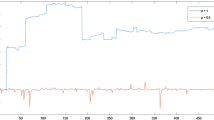Abstract
In this paper we derive an explicit expression for the log likelihood function of a continuous-time autoregressive model. Then, using earlier results relating the autoregressive coefficients to the set of positive parameters called residual variances ratios, we develop an iterative algorithm for computing the maximum likelihood estimator of the model, similar to one in the discrete-time case. A simple noniterative estimation method, which can be used to produce an initial estimate for the algorithm, is also proposed.
Similar content being viewed by others
References
M. Arato, On sufficient statistics of Gaussian process with rational spectral density function,Theory Probab. Appl.,30 (1986), 103–116.
O. E. Barndorff-Nielsen and G. Schou, On the parametrization of the autoregressive model by partial autocorrelations,J. Mult. invariate Anal.,3 (1973), 408–419.
G. Baxter, A strong limit theorem for Gaussian process,Proc. Amer. Math. Soc.,7 (1956), 522–527.
B. W. Dickinson, Autoregressive estimation using residual energy ratios,IEEE Trans. Inform. Theory,24 (1978), 503–506.
J. Doob,Stochastic Processes, Wiley, New York, 1953.
J. Durbin, The fitting of time series models,Rev. Inst. Statist.,28 (1960), 233–244.
K. O. Dzhaparidze and A. M. Yaglom, Spectrum estimation in time series analysis, inDevelopments in Statistics, Vol. 4 (P. R. Krishnaiah, ed.), pp. 1–96, Academic Press, New York, 1982.
J. Hajek, On linear statistical problems in stochastic processes,Czechoslovak Math. J.,12 (1962), 404–444.
S. M. Kay, Recursive maximum likelihood estimation of autoregressive processes,IEEE Trans. Acoust. Speech Signal Process.,31 (1983), 56–65.
R. S. Liptser and A. N. Shiryayev,Statistics of Random Processes, Vols. I and II, Springer-Verlag, Berlin, 1978.
D. T. Pham, Maximum likelihood estimation of autoregressive model by relaxation on the reflection coefficients,IEEE Trans. Acoust. Speech Signal Process.,36 (1988), 1363–1367.
D. T. Pham and A. Le Breton, Levinson-Durbin-type algorithm for continuous-time autoregressive model and applications,Math. Control Signals Systems,4 (1990), 69–79.
R. Vijayan, H. V. Poor, J. B. Moore, and G. C. Goodwin, A Levinson-type algorithm for modelling fast sampled data,IEEE Trans. Automat. Control,36 (1991), 314–321.
Author information
Authors and Affiliations
Rights and permissions
About this article
Cite this article
Le Breton, A., Pham, D.T. Maximum likelihood estimation for continuous-time autoregressive models by relaxation on residual variances ratio parameters. Math. Control Signal Systems 6, 62–75 (1993). https://doi.org/10.1007/BF01213470
Received:
Revised:
Issue Date:
DOI: https://doi.org/10.1007/BF01213470



